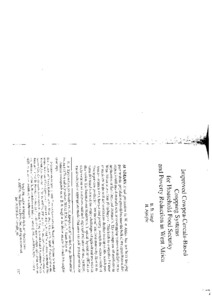| dc.contributor.author | Singh, B.B. |
| dc.contributor.author | Ajeigbe, Hakeem A. |
| dc.date.accessioned | 2019-12-04T11:14:10Z |
| dc.date.available | 2019-12-04T11:14:10Z |
| dc.date.issued | 2007 |
| dc.identifier.citation | Singh, B.B. & Ajeigbe, H. (2007). Improved cowpea-cereals-based cropping systems for household food security and poverty reduction in West Africa. Journal of Crop Improvement, 19(1-2), 157-172. |
| dc.identifier.issn | 1542-7528 |
| dc.identifier.uri | https://hdl.handle.net/20.500.12478/2670 |
| dc.description | Published online: 03 Oct 2008 |
| dc.description.abstract | Food production in West Africa has not been keeping pace with the population growth because the bulk of the agriculture in this region is still based on traditional inter-cropping systems with little or no application of fertilizers and chemicals. The average use of fertilizers in West Africa is less than 10 kg/ha/year. This leads to a negative balance of nutrients in the soil and continuous decline in crop yields, which perpetuates malnutrition, hunger and poverty through the vicious circle of ‘low inputlow production-low income’ and food insecurity. How to reverse this trend is one of the major challenges of agricultural research in this region. The International Institute of Tropical Agriculture (UTA), in collaboration with relevant national, regional and international partners, has developed an appropriate model that seems to hold great promise for increasing food production in West Africa without affecting the environment and degrading the soils. This model involves a holistic combination of new, more productive dual purpose and resilient cultivars of cowpea [Vigna unguiculata (L.) Walp.], maize (Zea mays L.), sorghum [Sorghum bicolor (L.) Moench] and millet (Pennisetum glaucum and other species) in a strip-cropping pattern with a minimum and selective application of fertilizers and pesticides, feeding of crop residues to small ruminants in permanent enclosures on the home compound and returning of manure to the field. Based on this model, two ‘best bet’ options have become popular with farmers in northern Nigeria. These are: (1) an improved strip-cropping system involving two rows of a densely planted, improved sorghum variety: four rows of a densely planted, improved medium-maturity cowpea variety in the Sudan savanna where the rainfall is about 600 mm and (2) an improved strip-cropping system involving two rows of a densely planted, improved maize variety: four rows of densely planted double cropping of an improved 60-day cowpea in the northern Guinea savanna where the rainfall is about 1000 mm. The two-third cowpea and one-third cereal combination minimizes fertilizer use and maximizes profit because of the higher prices of cowpea grain and fodder and at the same time it leaves positive residual soil nitrogen balance and reduces Striga hermonthica seed bank, both of which benefit the cereal crops. This combination is also appropriate in view of the global surplus of cereals and global deficit of legumes. The on-station and on-farm evaluation of these systems covering several states and more than 2000 farmers in northern Nigeria, with the financial support from USAID, Gatsby Foundation and DFID, has shown over 300% increase in productivity, enhanced income generation and improved livelihoods of the farm families. |
| dc.description.sponsorship | United States Agency for International Development |
| dc.description.sponsorship | Gatsby Charitable Foundation |
| dc.description.sponsorship | Department for International Development, United Kingdom |
| dc.format.extent | 157-172 |
| dc.language.iso | en |
| dc.subject | Cowpeas |
| dc.subject | Cereal Crops |
| dc.subject | Intercropping |
| dc.subject | Food Security |
| dc.subject | Farming Systems |
| dc.subject | Cropping Systems |
| dc.title | Improved cowpea-cereals-based cropping systems for household food security and poverty reduction in West Africa |
| dc.type | Journal Article |
| dc.description.version | Peer Review |
| cg.contributor.affiliation | International Institute of Tropical Agriculture |
| cg.coverage.region | Africa |
| cg.coverage.region | West Africa |
| cg.coverage.country | Nigeria |
| cg.authorship.types | CGIAR single centre |
| cg.iitasubject | Cowpea |
| cg.iitasubject | Crop Systems |
| cg.iitasubject | Farming Systems |
| cg.iitasubject | Grain Legumes |
| cg.journal | Journal of Crop Improvement |
| cg.howpublished | Formally Published |
| cg.accessibilitystatus | Limited Access |
| local.dspaceid | 93485 |
| cg.targetaudience | Scientists |
| cg.identifier.doi | https://dx.doi.org/10.1300/J411v19n01_08 |

